by California Casualty | Firefighters |
Drones: They are the new rage with millions now in the hands of hobbyists across the nation. They hoover, dive and provide amazing videos of dramatic scenery and inaccessible areas. While unmanned aircraft systems (UAS) can provide exciting new ways to recreate and view your neighborhood, they are also threatening firefighting operations across the U.S. The incidence of unauthorized drones spotted in fire areas across the country has increased dramatically the past few years, and the situation appears to be getting worse.
Unmanned aircraft have disrupted and canceled water and retardant drops because of the fear of a collision with firefighting planes. It’s also a hazard to smoke jumpers, helicopters and crews on the ground. Flying a drone near a fire is not only dangerous, it is illegal.
Anyone caught interfering with firefighting operations with a drone can be arrested and could face a $25,000 fine and criminal prosecution.
The following are some new strategies being employed to alert UAS pilots to areas they cannot fly, and to stop them if they do.
The FAA has is creating temporary “no-fly zones” around fires and making the information available to pilots of all types, especially recreational drone users. The FAA is urging all UAS operators to visit and download the B 4UFLY smartphone app that provides the restrictions in their area.
The U.S. Department of Interior has launched the “If YOU Fly, We Can’t” campaign with videos, PSAs and posters alerting drone owners of the risks.
Technology is also being tested to prevent drones from flying in areas where a restriction is in place. GPS and geo-fencing systems can literally ground a UAS in a fire-restricted area. The electronic blocking is already being employed around airports, military bases, nuclear power plants and the nation’s capital.
Keep in mind, it often takes a day or two before fires are noted and mapped for the system and the FAA warns that all pilots, including drone operators, are responsible for knowing the rules and local ordinances. In other words, you are responsible for flight safety at all times and can be cited for any careless or reckless actions that endanger others in the air or on the ground.
The FAA requires all operators to be 13 years or older and to register any drones that weigh more than .55 pounds. All UAS pilots must also adhere to these rules:
- Fly no higher than 400 feet
- Keep the UAS within sight
- Never fly near other aircraft, especially near airports
- Never fly over groups of people, stadiums or sporting events
- Never fly near emergency response efforts such as fires
- Never fly under the influence
- Be aware of airspace requirements
All the restrictions can be viewed at https://www.faa.gov/uas/getting_started/fly_for_fun/.
Education about the risk is considered the key to preventing more of these situations. If you have a drone, you need to know the rules of where and when to fly and be aware of the dangers to others. If you are a first responder, you may want to share this information with as many people as possible.
Firefighter’s jobs are already dangerous enough, that’s why California Casualty is asking all of us to be careful and know important drone rules that can save lives.
by California Casualty | Firefighters |
The National Volunteer Fire Council (NVFC) named Parker Ketler the 2017 Junior Firefighter of the Year at its spring board meeting April 7. California Casualty is a proud sponsor of the Junior Firefighter of the Year award and we were pleased to present Parker with his momentous achievement.
It’s easy to see why the NVFC chose him for the honor. Parker is the stepson of a firefighter and spent much of his childhood at the Sebring, Ohio Fire Department. That early exposure helped him excel when the department launched an Explorer Post in 2010. Chief Brian Anderson said that Parker was the obvious choice to become the Post’s first president.
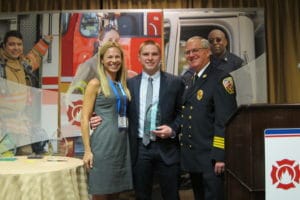
Parker is dedicated to public safety; described as ambitious, eager and hardworking. He would often volunteer to do maintenance and other tasks at the fire station as a teen, and participated in demonstrations for other fellow students about the dangers of distracted driving.
Parker has earned several awards, including the 2016 Distinguished Volunteer Service Cross Commendation from the Village of Sebring, Alliance Elks Teen of the Month and the Award of Excellence for Sportsmanship, Ethics, and Integrity from the Ohio High School Athletic Association.
Parker continues his love for the fire service, pursuing a degree in Fire Science at Columbus State University, where he has earned his Firefighter I and II certifications and is undergoing EMT training. He has joined the Sebring Fire Department as a firefighter and serves each weekend with the department when his studies allow.
California Casualty is proud to serve firefighters, like Parker, for more than 40 years. Our company also provides funding for the NVFC Junior Firefighter Program Starter Kit, which aids fire agencies in starting their own program for their communities and to help develop future volunteer and career firefighters. Learn more about the Program at https://juniors.nvfc.org/resources.
by California Casualty | Firefighters |
Emergencies happen daily, and firefighters are the heroes to come to the rescue. As technology is constantly changing, it’s important that firefighters stay updated on the newest vehicles that have lithium-ion batteries and alternative fuel.
Here are some suggested guidelines for firefighter safety:
• Wear full PPE and SCBA
• Identify the type of vehicle involved
• Stabilize vehicle
• Use large volume of water to cool the fire and battery
• If possible, follow the wrecker to the storage area and place the car away from other vehicles, buildings, or combustibles.
Firefighters are trying to keep pace with the changing components and features of these cars. With new technology developing daily, firefighters face a challenge with new cars.
by California Casualty | Firefighters |
by Nick Magoteaux
Fighting fire in a rural environment is much different than fighting fire in an urban or suburban environment. Firefighters face many challenges in the rural setting, like lack of water, extended response time, and lack of manpower, just to name a few. Unlike urban or suburban area, rural areas do not have hydrants so this means firefighters must bring water to fight the fire. Many rural fire departments depend on volunteer firefighters, which in many cases respond from home to the fire station and then go to the fire. This factor and distance from the firehouse can lead to extended response times. Finally, and almost most importantly, is the lack of manpower. Volunteerism is unfortunately slowly dwindling away putting a strain on volunteer fire departments.
According to the United States Fire Administration, volunteer firefighters have declined by 13% or more. This has caused many fire departments to resort to hiring fire and EMS personnel to staff the station during the day or around the clock. This leaves many departments struggling to operate. Many volunteer or part time fire departments struggle to purchase or replace needed equipment due to tight budgets. Federal resources are drying up and taxpayers are less likely to approve higher funding for fire departments. This leaves these volunteer or part time fire departments in a bind.
Many firefighters can attest that they often don’t have the proper tools to do their job, but in a job where you improvise, adapt, and overcome, they make it work. There are many newer tools and equipment that can make firefighting more efficient or time saving. In a job where seconds counts, wouldn’t you want your fire department to have those newer, more efficient tools? That’s where Brothers Helping Brothers steps in. Brothers Helping Brothers specializes in helping the small and rural departments who are struggling to operate.
Brothers Helping Brothers is a 501c3 non-profit organization that works with firefighting equipment manufacturers and distributors to obtain tools and equipment at a lower rate, and grants them to struggling small and rural fire departments. Brothers Helping Brothers is completely funded by private donations. You can help struggling fire departments by donating to Brothers Helping Brothers.
- By donating just $10 per month, you can put a new axe or hand tool in the hands of a firefighter that needs it to battle a blaze. That’s only 33¢ a day.
- By donating just $25 per month, you can outfit a firefighter with a new set of boots, which may have been desperately needed to be replaced. That’s only 83¢ a day.
- By donating just $50 per month, you can purchase the Jaws of Life enabling that department to save a victim from an auto accident. That’s only $1.66 a day.
Donating just $100 per month can purchase a new SCBA air pack for a department who maybe using out dated one and with that air pack a firefighter could perform a rescue during a fire safely. That’s only $3.33 a day.
To learn more about Brothers Helping Brothers, or to how you can help. Please visit their website at www.brothershelpingbrothers.org.
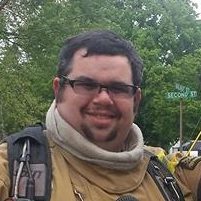 Nick Magoteaux has been in public safety for over 15 years. Nick has experience in law enforcement, dispatching, firefighting, and emergency medical service. Nick currently works for four different fire departments in Southwest Ohio, including the busiest fire department per capita in the state. Nick is also the founder and co-executive director of Brothers Helping Brothers, a fire service 501c3 non-profit that specializes in equipment grants to small and rural fire department in the U.S. Contact Nick at [email protected].
Nick Magoteaux has been in public safety for over 15 years. Nick has experience in law enforcement, dispatching, firefighting, and emergency medical service. Nick currently works for four different fire departments in Southwest Ohio, including the busiest fire department per capita in the state. Nick is also the founder and co-executive director of Brothers Helping Brothers, a fire service 501c3 non-profit that specializes in equipment grants to small and rural fire department in the U.S. Contact Nick at [email protected].
by California Casualty | Firefighters |
The job of a first responder is very challenging. In an earlier article I stressed the importance of mental health. I am now turning my focus to the physical aspects we face at work. It is imperative that we stay in the best shape possible. We owe it to the community we serve and our fellow brothers and sisters.
It’s not as easy as one would think. Many firefighters have turned to CrossFit, which is good for some but not for everyone. One of the best things your department can do is provide time and equipment to stay in top physical shape. We need to be cardiovascular fit, strong, flexible and keep our minds in shape. Shift work can make it difficult to train so we must train at work.
I have never been one who loves the gym or working-out inside. With our jobs we need to find balance and learn to cross train. With this said, most of us need to hit the gym at work. Some of us work 24s and others work 48s; my dept is on a 48 hour shift. Working shifts means you have to utilize whatever workout your dept. offers. We have a gym we can go to and exercise equipment in our station. I choose to utilize our station equipment.
We have stationary bikes, elliptical machines, free weights and a nautilus weight machine. Personally I like to spin. Cardiovascular training is just as important as weight training. Some departments use cross fit, which is good but be careful jumping into this if you are out of shape. Cross Fit is something you should and can work up to. Some departments are using firefighter specific workouts. Whatever you do it should include cardio.
Cardiovascular training, in my opinion, is necessary. When you are working a structure fire you are only as strong as the weakest link on your team. We go in as a team and come out as a team. If one of the members of your team is not up to par with the others, you can only stay interior as long as the weakest link. It is detrimental to the unit if one of your members burns through a bottle of air at twice the rate of the others. You may be doing an interior attack or a search. If one member is low on air we all must exit the building. This is non-productive. It is one of the reasons cardiovascular training is so important. Of course the main reason is our heart is a muscle. If we don’t exercise it we will be at risk of a cardiac event. This could lead to what is called an incident within an incident. This incident can cause your brothers and sisters a great amount of stress, PTSD, and may even lead to a suicide in your dept.
While I push the importance of cardio, weight training is also essential. You don’t have to lift heavy weights, in fact it’s better to lift light with high reps. Going with light weights will increase your strength while elongating your muscles, which reduces the chance of injury on the job.
Core body strength and strengthening your back is imperative. With this said, you need to work your stomach and back. Next to heart attacks, back injuries are probably the number one reason firefighters and EMS personnel miss work. Cardiovascular training, weight training and core body strength can be achieved by making sure you train while on shift. If you don’t have equipment, find a workout program specific to the job. I encourage all chief officers to allow at least 1 hour of part of a day; 2 hours is optimal. You should always start and end your workout with stretching or yoga. On your days off, make your workouts fun.
You can run, bike, ski, hike, swim, paddle, climb, row or find something else to do outside. Personally I like to cross train with climbing, biking, skiing, stand up paddling and swimming. Find something that is fun in your area. It can be something different; in fact a great option is organized sports. At the very least, walk swiftly for 3 miles.
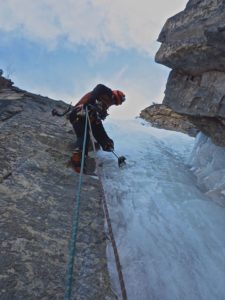 Personally, climbing is my favorite past time. I find climbing is the one sport that lets my mind rest. When I climb I can only think about the climb. This frees your mind by allowing it to focus only on the task of making it to the top. Climbing also increases strength and flexibility. I am fortunate to have the mountains and dessert as my playground. The last thing I would like to discuss is TRE therapy or meditation.
Personally, climbing is my favorite past time. I find climbing is the one sport that lets my mind rest. When I climb I can only think about the climb. This frees your mind by allowing it to focus only on the task of making it to the top. Climbing also increases strength and flexibility. I am fortunate to have the mountains and dessert as my playground. The last thing I would like to discuss is TRE therapy or meditation.
I find it difficult to meditate as my mind wanders. TRE therapy is taught in 35 countries. It stands for tension and trauma release therapy. I recently learned this and it is very easy and can be done at work or home. TRE includes a series of 7 steps. These steps end with the TRE tremor position. TRE uses the body’s innate process of controlled shaking to reduce stress and trauma, including PTSD. This revolutionary approach is doing wonders for me.
In conclusion, we are public servants. With this comes a responsibility to keep in shape. As we get older the stress of the job and life’s stressors can lead us to cope in unhealthy ways. I encourage you all to make a commitment to your community and fellow brothers and sisters. Of course we can’t control our genetic makeup, but we can make a commitment to physical and mental health. Let’s turn the tide towards less injury, death, PTSD and suicide of first responders. With a commitment we can turn the tide.
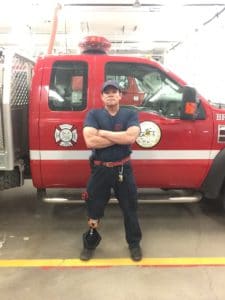 Jeff lost his right leg below the knee at the age of 50 as the result of a skiing injury. Instead of wallowing in pity, Jeff rebounded physically and mentally through physical therapy and exercise. He returned to work as firefighter/EMT a year later and is now back on the job fulltime. He strives to be the best firefighter/EMT he can be, and also to be an inspiration to others. Jeff welcomes your thoughts and comments at [email protected].
Jeff lost his right leg below the knee at the age of 50 as the result of a skiing injury. Instead of wallowing in pity, Jeff rebounded physically and mentally through physical therapy and exercise. He returned to work as firefighter/EMT a year later and is now back on the job fulltime. He strives to be the best firefighter/EMT he can be, and also to be an inspiration to others. Jeff welcomes your thoughts and comments at [email protected].
by California Casualty | Firefighters |
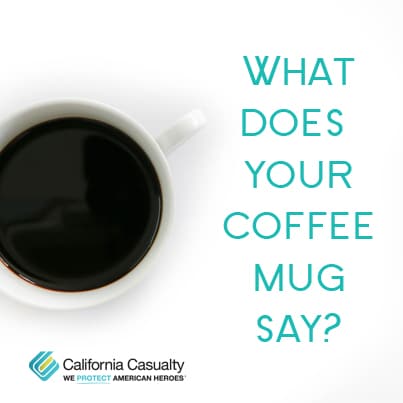
How do you start your day?
It seems most of us (myself included) love to get the morning (or evening if you work shifts) started with a good cup of coffee or tea. As you go through your day, have you noticed just how many mugs have a slogan or saying on them. It seems that what’s on our cup often gives a glimpse of who we are and what we think.
After doing a little research, we’ve assembled a list of some of the best sayings we’ve found on firefighter’s mugs:
- I do battle with the Angel of Death forty hours a week. And what do you do for a living?
- All men are created equal then some become firefighters.
- You Might Know Where You Are, God Might Know Where You Are, But If DISPATCH Doesn’t Know Where You Are Then You and God Better Be On Good Terms.
- Do NOT Make Me Use My Paramedic Voice!
- Volunteer Firefighters Do It For Free.
- Firefighters: The Hotter It Is The Quicker We Come.
- Firefighters do it with a big hose.
- I still play with trucks.
- EMS: Hours of boredom occasionally interrupted by minutes of sheer terror.
- I Hate Being Sexy But I’m A Firefighter So I Can’t Help It.
- Hug A Firefighter And Feel Warm All Over.
- Firefighters can take the heat.
- Firefighter By Day, Zombie Slayer By Night.
- I’m The Firefighter Your Mother Warned You About.
- FIREFIGHTER: Being Awesome Is Just Part Of the Official Job Description.
- Beak the Speed Limit, Carry an Ax in Public, Run Red Lights; Oh Yeah, Make Sure You’re a Firefighter
What does your favorite mug have on it? We’d love to see; feel free to share it with us.
And just like a comforting cup of hot coffee, California Casualty is a perfect complement to your day. We’ve been protecting American heroes for over 40 years providing auto and home insurance matched to your professional lifestyle. That means these exclusive benefits not available to the general public:
- Waived or reduced deductibles for vandalism or damage to your vehicle parked at work
- $500 coverage for personal items damaged in or taken from your vehicle (including turnout gear)
- Rates guaranteed for a full year (not six months)
- Free identity theft protection with each policy
- Fallen Hero survivor benefit
- Multiple payment options including EZ Pay and holiday or summer skips
- Superior customer service satisfaction rating – 99 percent with claims satisfaction of 96 percent
Call a California Casualty advisor today to learn about all the professional discounts you qualify for as a firefighter at 1-(866)-441-4635, or visit www.calcas.com/firefighters.


 Nick Magoteaux has been in public safety for over 15 years. Nick has experience in law enforcement, dispatching, firefighting, and emergency medical service. Nick currently works for four different fire departments in Southwest Ohio, including the busiest fire department per capita in the state. Nick is also the founder and co-executive director of Brothers Helping Brothers, a fire service 501c3 non-profit that specializes in equipment grants to small and rural fire department in the U.S. Contact Nick at
Nick Magoteaux has been in public safety for over 15 years. Nick has experience in law enforcement, dispatching, firefighting, and emergency medical service. Nick currently works for four different fire departments in Southwest Ohio, including the busiest fire department per capita in the state. Nick is also the founder and co-executive director of Brothers Helping Brothers, a fire service 501c3 non-profit that specializes in equipment grants to small and rural fire department in the U.S. Contact Nick at  Personally, climbing is my favorite past time. I find climbing is the one sport that lets my mind rest. When I climb I can only think about the climb. This frees your mind by allowing it to focus only on the task of making it to the top. Climbing also increases strength and flexibility. I am fortunate to have the mountains and dessert as my playground. The last thing I would like to discuss is TRE therapy or meditation.
Personally, climbing is my favorite past time. I find climbing is the one sport that lets my mind rest. When I climb I can only think about the climb. This frees your mind by allowing it to focus only on the task of making it to the top. Climbing also increases strength and flexibility. I am fortunate to have the mountains and dessert as my playground. The last thing I would like to discuss is TRE therapy or meditation. Jeff lost his right leg below the knee at the age of 50 as the result of a skiing injury. Instead of wallowing in pity, Jeff rebounded physically and mentally through physical therapy and exercise. He returned to work as firefighter/EMT a year later and is now back on the job fulltime. He strives to be the best firefighter/EMT he can be, and also to be an inspiration to others. Jeff welcomes your thoughts and comments at
Jeff lost his right leg below the knee at the age of 50 as the result of a skiing injury. Instead of wallowing in pity, Jeff rebounded physically and mentally through physical therapy and exercise. He returned to work as firefighter/EMT a year later and is now back on the job fulltime. He strives to be the best firefighter/EMT he can be, and also to be an inspiration to others. Jeff welcomes your thoughts and comments at 